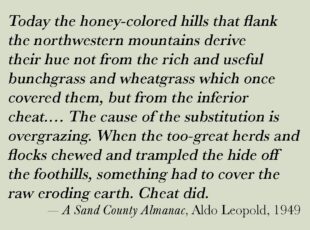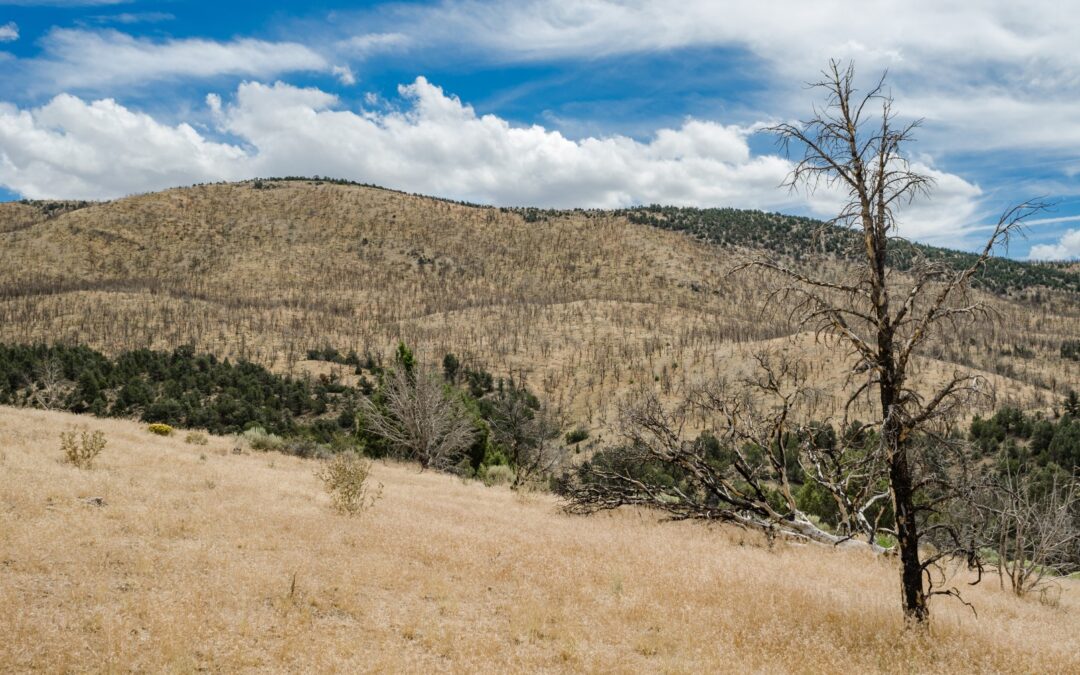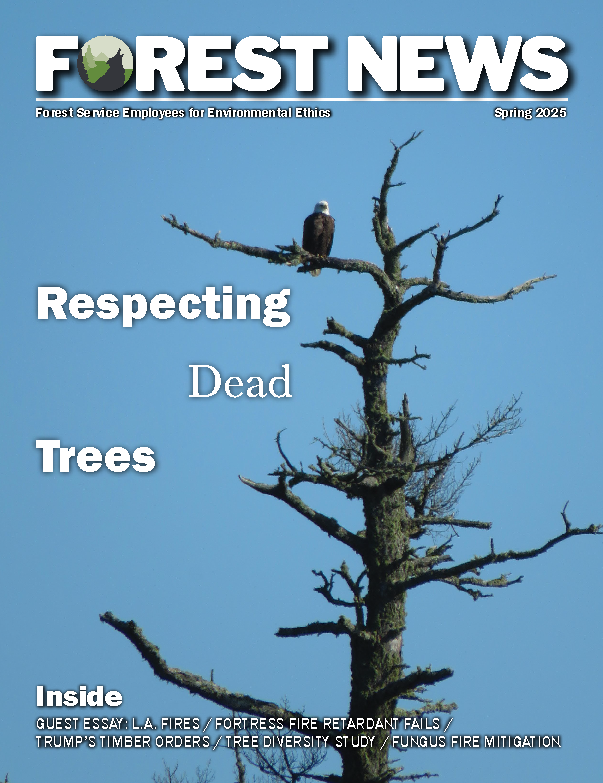‘One of the most significant ecological crises facing land managers in the arid West’
A report published in January, Cheatgrass Invasions: History, Causes, Consequences, and Solutions, by Western Watershed Projects is the source of the above quote. Authored by Erik Molvar, Roger Rosentreter, Don Mansfield, and Greta Anderson, the new report draws on a century of research and data supporting a firm scientific consensus that this invasive species fuels a “livestock-cheatgrass-fire cycle” which “now prevails across much of the public lands of the western United States.” As a result, those lands are now “susceptible to larger and more frequent fires.”
 Cheatgrass is the most widespread invasive weed in North America with millions of acres converted to cheatgrass monoculture and tens of millions of acres at risk of infestation. This annual grass from Eurasia was introduced to North America in the 1800s. Spread by railroads, vehicles, and livestock, it colonized lands that had been disturbed and degraded, mainly from overgrazing cattle. Molvar et al. provide a comprehensive review of scientific research on cheatgrass and evaluate solutions to restore healthy native ecosystems.
Cheatgrass is the most widespread invasive weed in North America with millions of acres converted to cheatgrass monoculture and tens of millions of acres at risk of infestation. This annual grass from Eurasia was introduced to North America in the 1800s. Spread by railroads, vehicles, and livestock, it colonized lands that had been disturbed and degraded, mainly from overgrazing cattle. Molvar et al. provide a comprehensive review of scientific research on cheatgrass and evaluate solutions to restore healthy native ecosystems.
A significant proportion of the public lands at risk from cheatgrass-fueled fire is managed by the Forest Service, an agency currently spending billions of tax dollars to “mitigate wildfire risk” by cutting down trees. These logging projects don’t address readily combustible fine fuels like cheatgrass, even though the risk is well-documented. The Boy Scouts understand fine fuels, which they call tinder: “Thin, dry material that ignites instantly with a match. It’s the basis of every fire. Examples include dead, dry grasses….”
Cheatgrass produces two crops per year, providing dead, dry grasses in summer and fall. The spring crop of cheatgrass dies off by early summer, leaving “the basis of every fire” available for easy ignition at the height of fire season. According to Cheatgrass and Wildfire (Colorado State University Extension) “A typical cheatgrass fire on flat terrain with wind speeds of 20 miles per hour may generate flame lengths up to eight feet in height,” significantly putting cheatgrass in the category of “ladder fuel.” Increase the wind speed, and a cheatgrass fire becomes unstoppable — like the million-acre grass fire that recently burned in Texas.
Multiple scientific studies cited in the cheatgrass report demonstrate that “cheatgrass invasion creates larger and more frequent fires by creating continuity of fine fuels.” Anything from a roadside cigarette butt to a hot tailpipe on an ATV can ignite cheatgrass and spark a wildfire. And cheatgrass seeds are adept at surviving fire; therefore, cheatgrass fires often lead to establishment of a cheatgrass monoculture. “The costs and difficulties of combating both further cheatgrass expansion or retention — and minimizing the frequent fires that result — are high from both the ecological and the economic perspectives.” The science cited in the report puts the threshold for avoiding the ecological and economic consequences of cheatgrass infestation at between 5% and 25% of land area.
The cumulative advantages of this invasive weed over native bunch grasses make cheatgrass a formidable opponent. As the research demonstrates, two key factors facilitate cheatgrass dominance over native plant species:
- Ground disturbance.
- Seed spread.
Livestock grazing continues to cause ground disturbance, and the authors note, “Reduction or elimination of livestock grazing achieves results on a sufficiently large scale, but full restoration can take decades.” They also warn against prescribed fire and fuel-break construction, which “risk a worsening of cheatgrass infestations.”
For wildfire mitigation and containment activities, the report recommends avoiding the use of “ground-disturbing equipment,” which “creates a seedbed for cheatgrass.” The bulk of Forest Service funding for wildfire mitigation goes to mechanical tree-thinning, which employs ground-disturbing equipment like masticators, skidders, and feller bunchers. These mechanical “forest-health treatments” not only create conditions favorable to cheatgrass infestation, but the machinery used can introduce cheatgrass seeds, causing new infestations. Thinning trees also removes tree canopy, which provides more sunlight on the ground, further supporting the spread of cheatgrass.
Multiple studies identify prevention of ground disturbance as the best way to limit the spread of cheatgrass. Native ground cover in the arid West often consists of a “biological soil crust” (lichens and mosses) and “perennial bunchgrasses,” which are more resistant to ignition than cheatgrass. The combination of biocrust and bunchgrasses also creates a synergy that resists cheatgrass invasion. Soil-disturbing machinery destroys the biocrust and damages native grasses, inviting cheatgrass establishment; then, cheatgrass outcompetes native bunchgrasses.
Soil disturbance also damages the soil’s symbiotic fungal network, which supports native plant species, including trees, and it can take up to a decade for these fungi – i.e., mycorrhizae – to recover from mechanical disturbance. Native plant species rely on mycorrhizae, which enhance nutrient uptake, but cheatgrass can thrive without the fungi. Cheatgrass also expands rapidly “because it is a prolific seed producer, can germinate in spring and autumn giving it a competitive advantage over native grasses, is tolerant of grazing, and increases with fires,” according to a 1996 report — Cheatgrass: The invader that won the West.
Other studies show that cheatgrass “can outcompete native grasses for water and nutrients because it is already actively growing when native plants are initiating growth.” Cheatgrass “ultimately drains soils of available nitrogen, which helps cheatgrass exclude native grasses” and exhausts other soil nutrients needed by native plants. The science also shows that cheatgrass “depletes soil water in spring much more rapidly than native species,” preventing the survival of native seedlings and subjecting adult native plants to moisture stress.
For a litany of reasons, minimizing cheatgrass infestations and restoring infested lands to natural conditions should be “a priority dictating the outcomes of land-use and land management decisions throughout the arid West.” With their cheatgrass report, Molvar et al. add more scientific weight to the arguments against mechanical forest-thinning for fire mitigation. Recent record-breaking grass fires in Texas, Hawaii and Colorado reinforce their conclusions.
Featured Photo: Cheatgrass now dominates a former pinyon-juniper woodland following a wildfire in Nevada’s White Pine Range.


